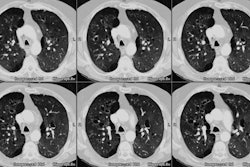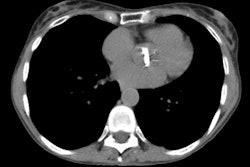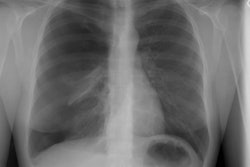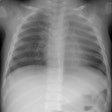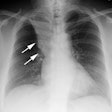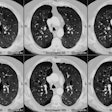AJR Am J Roentgenol 1995 Dec;165(6):1343-1348. Preoperative examination of lung transplant candidates: value of chest CT compared with chest radiography.
Kazerooni EA, Chow LC, Whyte RI, Martinez FJ, Lynch JP
OBJECTIVE. The purpose of our study was to determine the usefulness of CT in examining candidates for lung transplantation to detect cancer not visible on plain chest radiographs (a finding that would exclude a patient from transplantation) and to determine which lung is more severely diseased to aid in the decision of which side to transplant. MATERIALS AND METHODS. We reviewed the chest radiographs and CT scans of 190 transplant candidates during a 3-year period for findings suggestive of neoplasm, including lung nodules and atelectasis; we also reviewed the symmetry of disease. In the latter category, patients with primary pulmonary hypertension, Eisenmenger's complex (pulmonary vascular, not parenchymal, disease), and cystic fibrosis (for which bilateral transplantation is performed) were excluded. A total of 190 plain chest radiographs, 180 thin-section CT scans, and 31 standard CT scans were reviewed retrospectively. RESULTS. Plain chest radiographs revealed 20 noncalcified nodules; 13 were 8 mm or more in diameter, and 7 were less than 8 mm. CT scans revealed 66 noncalcified nodules; 37 were 8 mm or more in diameter, and 29 were less than 8 mm. Eight non-calcified nodules seen on plain chest radiographs were either absent on CT scans (and follow-up plain chest radiographs) or appeared calcified on CT scans. Solitary nodules in three patients proved to be bronchogenic carcinomas; two of these lesions were identified only on CT scans. CT prompted a change in the determination of which lung was more severely diseased from that made on the basis of plain radiography for 27 of 169 patients (16%) evaluated. Of the 45 patients who subsequently underwent transplantation, CT prompted a change in the determination of which side to transplant from that made on the basis of plain radiography for 4 patients (9%). CONCLUSION. CT provides additional information to supplement plain radiography in the examination of lung transplant candidates. This information can alter patient management, particularly when bronchogenic carcinoma is detected, and enable a better determination of which lung is more severely diseased to aid in the decision of which lung to transplant for single-lung transplantation.
PMID: 7484560, MUID: 96072672

